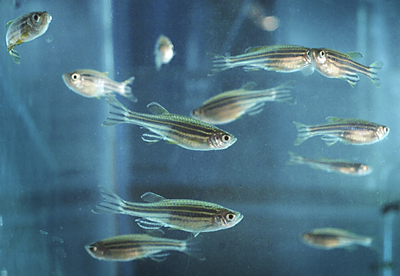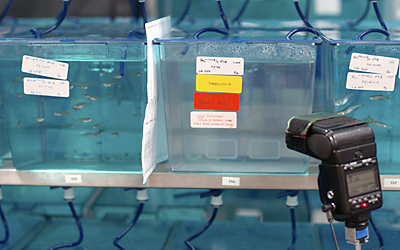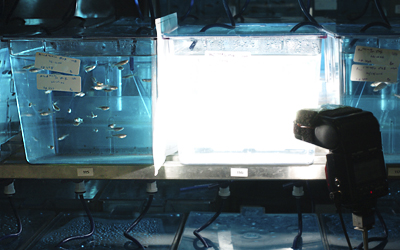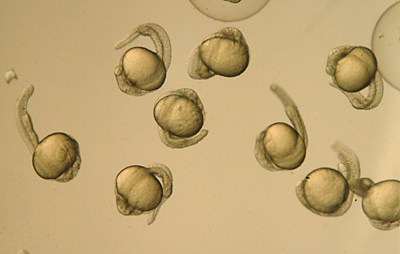 For whatever reason, I tend to get sent into laboratories on assignment pretty frequently.
For whatever reason, I tend to get sent into laboratories on assignment pretty frequently.Maybe they have taken a good, long look at my sports photography and decided that scientists might be easier for me to get in focus. I dunno.
About a month ago, I was assigned to photograph a scientist who was studying zebra fish zygotes to gain insight into their brain formation.
It was pretty cool, actually. The little suckers are not only completely transparent at this stage of their lives, but you can modify specific genes to fluoresce so you can track the genes' positions in the various developmental stages.
Along with the typical shots of the scientist and her assistant working in the lab, I wanted some close-ups of the cute little fishies and their new new little bundles of joy. At least the one the parents didn't eat.
But these guys are pretty small - an inch or so - as an adult. So you can imagine how small they are just 22 hours after conception.
In the process of figuring out a bootstrap solution, I came across two techniques that I will definitely use again. And I wanted to pass them along just in case there were any other zebra-fish-zygote-shootin' photographers out there.
The photo at top was lit with a off-camera Nikon SB-24, synched with a Pocket Wizard. I tried various ways of lighting the aquaria from the back, as the containers were blue and had a cool look when backlit.
They were all failures. The fish were too backlit and showed up as being too dark. If I had brought a second light with me, I would have had no problem. But I was on a college campus and parked the better part of a mile away.
(Boy, I do not miss those days.)
Besides, it was raining cats and dogs. So we were just going to have to do this one with one strobe.
After deciding I really needed a broad, close-up light source from the side, I set about creating one that would not reflect from the side of the aquarium. After scratching my head for a few minutes, I realized that I could make the side of the aquarium into a light source.
I took the sheet of paper on which my assignment was printed and slipped it between two aquaria, like this:

Then I used it to diffuse the light from the strobe by shooting through it. Presto, the aquarium becomes its own soft box. Here's a shot of the same scene with the light going off, adjusted for the proper flash exposure:

You can see how much better the fish are defined. In addition, the flash gave me all the aperture (and depth of field) I needed to keep the little buggers in focus as they swam around.
This last part was harder than it sounded. So I used what I call the "direct mail" approach. I just fired off a couple hundred frames - no kidding - in the knowledge that I would get good focus and positioning on several of them. Simple math.
The flash was pumping plenty of light out at even 1/16th power on manual, so shooting a gazillion frames was not a problem for the flash head overheating. Nor was I limited by recycle time - even with just AA's as my power source.
Having an acceptable shot of the adult fish in the can, the zygotes were next in line.
The scientist had them set up under a stereo microscope, and I hoped she had a Nikon adapter ring for shooting specimens with a camera.
She didn't. Oh, well. I didn't really expect the solution to be that easy. But I always ask. You never know.
So I took my lens off and gently tried to line my bare camera up to the eyepiece. (I have had success like this with telescopes on astronomy assignments.)
Close, but no cigar.
Next, I removed the eyepiece and tried the same thing.
Nope. Not even close.
On a whim, I replaced the eyepiece and put on a 50mm lens. Then I sloooowly lowered my camera down until the front element of my lens gently rested on the eyepiece glass.
Bingo:

I couldn't believe how clear it was. I don't know if it was the specific optical designs of my lens and the scope's lens, but it sure worked.
I'll remember this technique for later, too. If you try it, just be careful not to screw up your front element.
As it happens, I would be back in the lab within a couple of days, this time to photograph something even smaller: E. coli bacteria. (No biggie - tastes like chicken.)
But that's a different assignment, and will be the subject of a future post.
Next: Stainless Steel and Cookies




0 comments:
Post a Comment